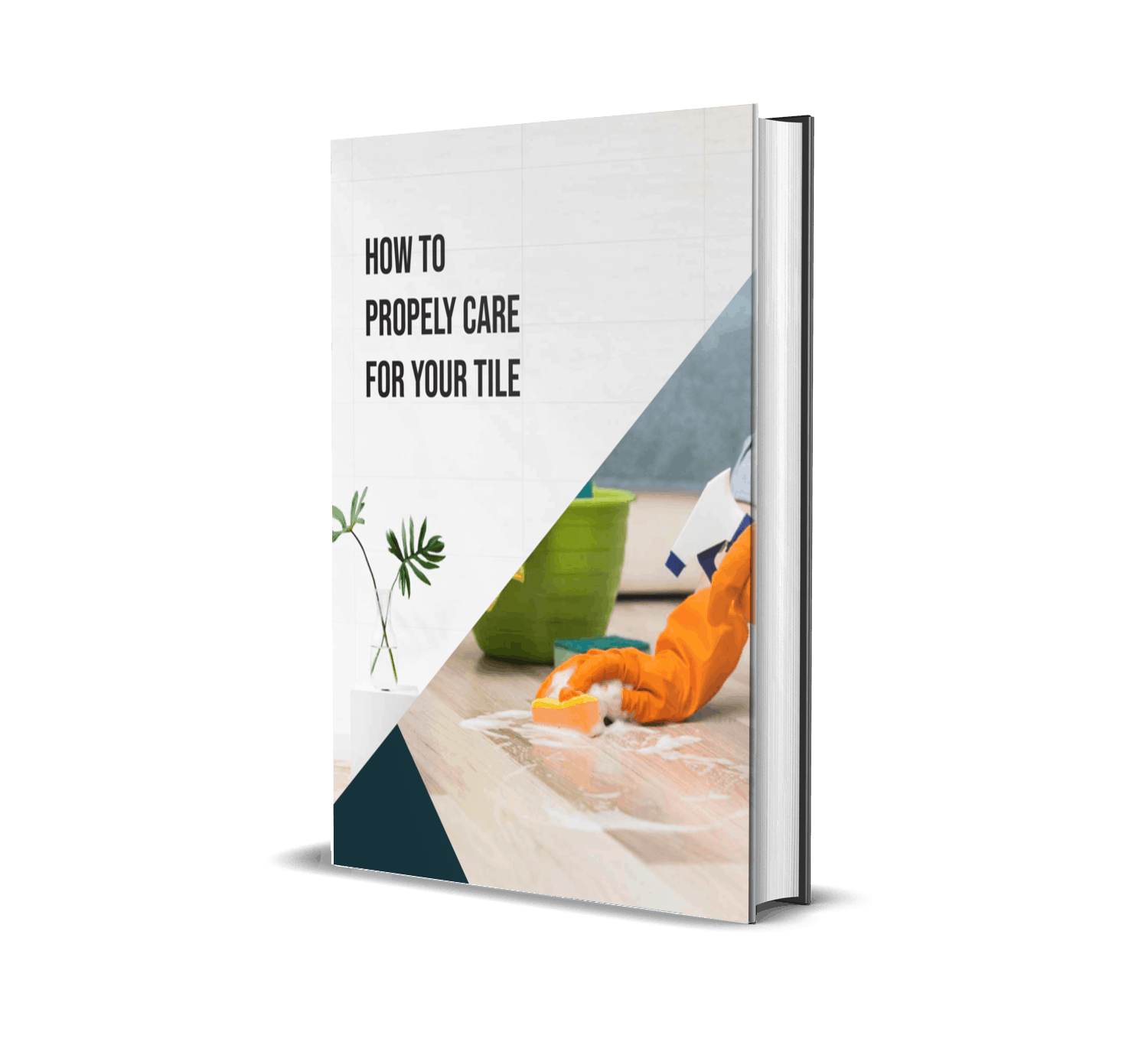The best way to have stain-free tile floors is to prevent stains in the first place. Too bad life isn’t always that easy. In the real world, you WILL have to deal with stains, but you can avoid many by thinking ahead about how to prevent them. One way to reduce the amount of staining on any tile surface is to make sure it is sealed with a good penetrating sealer or impregnator when installed.
In rooms with tile flooring, ensure there is at least one window and proper ventilation. If it’s a bathroom, install a fan to help keep the room from becoming too humid. A ceiling fan in other rooms will keep the air circulating. If the environment is very humid, a dehumidifier can be effective against humidity and stagnant air creating the perfect conditions for bacteria to grow.
As far as maintenance goes, mop floor tiles each week with warm water. If you notice mold forming, choose a specialized cleaning solution to keep stains and mold at bay. A tip on cleaners: Always start with the weakest cleaner and work your way up. You never want to permanently damage your tiles’ surface or the grout (we’re trying to prevent that here) by using a super strength cleaner.
Regular Cleaning of Tile and Stone Floors
How often you perform regular cleaning will depend on the level of foot traffic through your home, how much you use the space, and how many pets and humans you have in the house.
What to do:
- The first step is to sweep away dust, crumbs, and other debris.
- Next, wipe the floor with clean water. Believe it or not, water alone is enough to clean lightly soiled ceramic surfaces. No harsh chemicals are necessary!
- If you use a mop, be sure to sweep up debris beforehand and use a flat mop rather than a sponge mop to keep from pushing dirty water into the grout lines. That’s just going to make more work for you.
- Dry floor thoroughly after wiping with clean water. You can air-dry, use a microfiber cloth, or a dry flat mop.
- For deep cleaning, use a pH-neutral or mild alkaline detergent.
- Plastic and nylon scrubbers are great for times when you need a little extra help on those tough-to-remove spills and stains.
- When done, rinse thoroughly with clean, clear water to remove cleaner residue. Residue that’s left behind will attract dirt and create a dull appearance on your floor.
- Dry thoroughly and give your floors time to air dry or wipe them with a clean, dry mop or cloth.
What NOT to do:
- Don’t use acidic cleaners, including vinegar.
- Don’t use oil- or wax-based cleaners because the residue will attract dirt.
- Don’t use steel wool or abrasive scrubbers.
How to Deep Clean and Disinfect Porcelain Tile
In this instance, deep cleaning means using a cleaning solution instead of plain water. A study from the Centers for Disease Control and Prevention (CDC) found that a third of Americans are cleaning their tile incorrectly! Pay close attention here: The best cleaners for porcelain tile are the ones that are made specifically for tile and grout. Makes sense, right? But most people aren’t doing it. That’s why we repeat it here.
Disinfecting is a big deal for a lot of people right now. The good news is ceramic surfaces don’t need harsh cleaning chemicals. However, on occasion if you do need to use a disinfectant, it will not dull or damage porcelain like it may other non-ceramic surface materials.
Check out the Environmental Protection Agency’s (EPA’s) list of disinfectants to choose the correct one for cleaning specific bacteria or viruses. When cleaning is complete, thoroughly rinse with clean water to keep residue from drying on the tiles.
Note: Follow the label’s instructions for safe use.
How to Deep Clean Grout
Now let’s move on to cleaning the grout. It’s logical that you’ll clean your grout when you clean your tile. However, over time grout can develop stains or other issues. These require a little extra care:
- Deep clean: Scrub the grout using a grout brush (or an old toothbrush) and a cleaner formulated for tile and grout. If possible, use a wet-dry vacuum to suck up the dirty water. Then rinse with clean water and vacuum that up, too to remove any residual soap. (If you don’t have a wet-dry vacuum, simply rinse with clean water and dry the grout with a towel.)
- Remove stains: Tough stains may be easy to remove with a steam cleaner. The pressurized steam forces the stain to the grout’s surface, and then you can easily scrub it away.
Tile and Grout Cleaners Types
There are three categories for cleaners:
- Alkaline (cleaners with a pH above 7)
- Acidic (cleaners with a pH below 7)
- Neutral (cleaners with a pH of 7)
When water alone won’t work, neutral tile and grout cleaners are the best options. If neutral cleaners aren’t strong enough, you can try a mildly alkaline detergent but never use an acidic cleaner.
The Most Common Stain Categories for Stone
So now we move on to stone tile stains, which can drive you crazy if you can’t figure out how to get rid of them. That one small spot will eventually feel like it’s grown large enough to see from space.
Let’s check out the most common stain types:
Type of Stain / Cause
- Biological / Mildew, mold, algae, lichens, etc.
- Organic / Coffee, tea, certain fruits and juices, wine, tobacco, etc.
- Oil-Based / Grease, cooking oils, tar, and food stains.
- Ink / Permanent marker, pen, ink, etc.
- Metal / Copper, bronze, iron (rust), etc.
Poulticing Powders:
There are several poulticing powders you can use to remove stains. The best are diatomaceous earth and clays like attapulgite, kaolin, and fullers earth. Poulticing powders work with water to go below the surface and draw the stain out of the stone.
DIYers Beware: Never use clays on rust stains, and never use whiting (chalk) or iron-type clays with acidic chemicals, which will negate the cleaning power of the poultice.
Stain Removing Chemicals
How do you choose the proper chemical to remove a stain? First, identify the stain. This is the most important step. If you know what caused the stain, you can look at a stain removal chart for the proper chemical to apply.
If you don’t know for sure, try to figure it out by color, shape, or pattern. Do your best impression of Sherlock Holmes by using your powers of observation and perform some investigation to deduce the answer to Name That Stain.
Stain Removal Guide
Here’s an extremely handy guide for removing stains from stone tile by Frederick Hueston, the Founder of Stone Forensics:
- Coffee, Tea & Food – Poultice with 20 percent Hydrogen Peroxide + Powder.
- Copper – Poultice with Ammonium Chloride + Powder.
- Ink – Poultice with Mineral Spirits or Methylene Chloride +Powder.
- Iron (rust) – Poultice with Iron Out + Powder + Water. (Iron Out is available at hardware stores). Both mixtures may etch polished marble; so re-polishing will be necessary.
- Oil – Poultice with Ammonia+ Powder Methylene Chloride can also be used on tough oil stains.
- Paint (oil) Poultice with Mineral Spirits + Powder. Deep stains may require Methylene Chloride.
- Paint (water-based) – poultice with a commercial paint remover + Powder.
Conclusion
The next time you find a stain on your tile flooring and no one will confess, no need to lose your cool. This information can guide you step-by-step to removing stains from your porcelain and stone tiles without too much time or trouble.
Sources:




